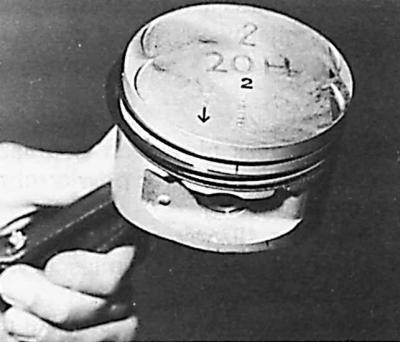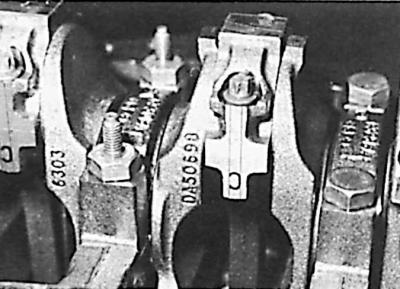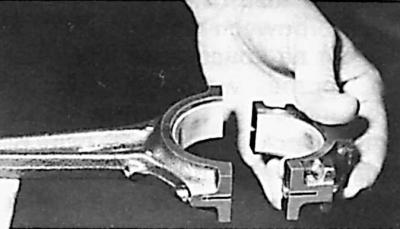- thorough washing of all parts;
- replacement of damaged (or worn) O-rings and paper gaskets;
- compliance with the appropriate tightening torques for threaded connections;
- using new cylinder head bolts and tightening them in the appropriate sequence;
- observance of the correct combinations of interacting elements (must be in the same places in which they were located before disassembling the engine).
Designation on the bottom of the engine piston DOHC

The arrow on the bottom of the piston during installation must be directed towards the drive of the gas distribution system (to the front of the engine).
DOHC engine connecting rod cap designation

The top picture is the designation of a complete set with a connecting rod.

The bottom picture is an indication of the correct position of the cover relative to the connecting rod.
Measuring the piston clearance in the cylinder
1. Put on the main bearing caps without shells and tighten their mounting bolts to the required torque.
2. Rotate the motor 180° (cylinder bores up).
3. Measure the cylinder diameters. If these diameters exceed the corresponding values (see subsection 3.1.4.3.1.2), you should regrind the cylinders to the repair size or replace the engine block and select the appropriate pistons.
4. Remove main bearing caps.
Measuring the clearance in the main bearings of the crankshaft
1. Insert the shells into the main bearing seats of the cylinder block.
2. Install crankshaft in bearings.
3. Lay a Plastigage measuring rod with a length equal to the width of the bearing along the main journal in the bearing of which the clearance is to be measured, put on the appropriate main bearing cap together with its bearing and tighten the cap bolts to the required torque.
Attention! During this operation, the crankshaft must not be rotated.
4. Remove the main bearing cap along with its bearing.
5. Compare the width of the deformed stylus with the scale supplied with the stylus and determine the journal clearance in the bearing from this. If the gap exceeds the allowable limits, then the main bearings should be replaced.
Engine Assembly
1. Install the main bearing shells in the engine block sockets (do not lubricate the outer surface of the liners with oil).
2. Lubricate the sliding surface of the main bearing shells with engine oil and install the crankshaft in the main bearings.
3. Install main bearing caps (The arrow on the cover points towards the front of the engine) along with their inserts (with sliding surface also lubricated with engine oil) and insert the thrust washers of the crankshaft into the seats of the middle main bearing.
4. Install a micrometer indicator to the crankshaft axis to measure the shaft end play.
5. Using a screwdriver, move the crankshaft longitudinally within the axial play and read the indicator readings.
6. Compare this value with the correct value (see subsection 3.1.4.3.1.3).
7. If necessary, replace the thrust half rings of the crankshaft with half rings of the required thickness to ensure the correct axial clearance of the crankshaft and check this clearance again.
8. Check the clearance of the piston ring locks after installing them in the engine cylinders. If necessary, replace rings with incorrect lock clearance.
9. Put the checked rings on the pistons.
10. Arrange the ring locks evenly around the perimeter of each piston. This also applies to the elements of the oil scraper ring in relation to its expander (expanding spring).
11. Insert the pistons together with the connecting rods into the engine cylinders. The arrow on the bottom of the piston must be directed towards the drive of the gas distribution system (towards the front of the engine).
12. Insert the connecting rod bearings with the sliding surface lubricated with engine oil into the lower ends of the connecting rods.
13. Put on the connecting rod caps together with the bearings, screw in new bolts and tighten the connecting rod bolts to the appropriate torque.
14. Check the value of the axial clearance of the connecting rods on the connecting rod journals of the shaft.
15. Press a new gearbox input shaft bearing into the hole at the end of the crankshaft.
16. Remove the crankshaft rear O-ring from the cylinder block rear cover.
17. Screw the rear cover onto the engine block.
18. Lubricate the lip of the new crankshaft O-ring with engine oil and slide it onto the rear cover of the cylinder block using a plate and two flywheel mounting bolts (The inner diameter of the plate must be larger than the sealing diameter of the shaft, and the outer diameter must be equal to the outer diameter of the rear sealing ring).
19. Screw the front cover to the cylinder block together with a new gasket.
20. Screw the oil pan baffle to the cylinder block from below (oil deflector) and the oil receiver of the oil pump and the mesh with a new gasket.
21. Install the oil pan with a new gasket, tightening the mounting bolts to the required torque.
22. Screw the flywheel to the crankshaft with new bolts.
23. Center the clutch disc and attach the clutch drive to the flywheel.
24. Screw on the crankshaft position sensor and oil pressure sensor.
25. Install oil pump (see subsection 3.1.4.4.11).
26. Install the oil filter and coolant pump on the cylinder block.
27. Install the cylinder head gasket.
28. Install the piston of the 1st cylinder at a distance of about 20 mm from TDC.
29. Install the cylinder head, screw new head bolts into the holes and tighten them in the appropriate way (for cylinder head installation, see subsection 3.1.4.4.8).
30. Lubricate with oil and install hydraulic tappets in the guides.
31. Lubricate the camshaft bearings with engine oil and install both shafts on them.
32. Fit the camshaft bearing caps and tighten their bolts to the correct torque.
33. Install sprockets and timing chain (see subsection 3.1.4.4.7).
34. Install the top chain guide.
35. Fit the oil pump drive chain and sprocket.
36. Install the oil pump chain tensioner.
37. Install the key in the groove of the crankshaft.
38. Put on the lower casing of the cardan chain of the gas distribution system.
39. Install the crankshaft vibration damper, align the lower propeller shaft housing of the timing chain and tighten its bolts to the appropriate torque.
40. Put on the upper casing of the universal joint chain of the timing system, paying attention to the laying of its gasket, and tighten the bolts of its fastening to the appropriate torque.
41. Install the cylinder head cover with a new gasket, tightening the gasket bolts to the correct torque.
42. Screw in the drain plug of the cooling system together with a new gasket.
43. Screw in the spark plugs, connect the high voltage wires and screw on their holder.
44. Install the crankcase ventilation piping.
45. Install the alternator, put on the alternator drive and coolant pump V-belt and adjust its tension.
46. Fill the engine with the required quantity of the appropriate oil and insert the oil level indicator.
Visitor comments